So You Want to Walk the 100km Megamarsch.
About two months ago, I walked the Megamarsch Hamburg, a 100km urban trail hike in one long 24-hour period. Now that I’ve recovered from the experience, I thought I would set out some material about it in English for anyone outside of Germany who is thinking of attempting this. There’s a fair amount of German-language material on this event, but it’s spread out over forums, Facebook, and strangely formatted PDFs on the Megamarsch website. Hopefully this makes research a little easier for you.
I’ll give basic info, organizational and cultural hangups to look out for, an idea of what you’re getting into, and an idea of what gear and training you will need. The post will finish off with checklists and the blow-by-blow account of my own experience. For the sake of suspense I won’t reveal if I finished the event until the very end.
What is the Megamarsch?
That’s a really good question, and I don’t have a the definitive answer for you. There appears to be an organization called Megamarsch which runs a number of similar events, of varying lengths, at various German cities. Walking for 100km in one go seems like a particularly German thing to do. However it’s not wildly popular or well-known. We ran into a couple of random Germans during the walk who knew what we were doing and seemed impressed by it, but my German friend who roped me into doing this had only heard about it about a year ago.
If you are familiar with large sporting events, then there’s a lot here which you will recognize. There’s a hefty signup fee. They don’t give you a free technical-fabric shirt like you’d get at most US races, but they do have a participant shirt for sale, and a 40-Euro finishers’ shirt at the end. There’s also a number of merch items, including a plastic cup for drinking water and tea at the rest areas, and one of those face sock things, loaded with branding. And don’t forget the official race photos provided at truly extortionary prices.

On the Megamarsch day you will have an assigned start time based on when you bought your ticket. Basically they send the walkers out in a steady trickle in order to limit the hardship on the streets and the rest stops. None of the course is closed off, you’re just out there like a civilian pedestrian. If you need to move your start time around, or you want to get a deal on a ticket, there’s a Facebook group where people wheel and deal the tickets. An official scalper forum essentially. It’s all done in German, but I had to do it, and you can do wonders with Google Translate these days. I can tell you that the process of signing over an Eventbrite ticket to someone anonymous on Facebook is particularly harrowing because it involves sending them all the information necessary to steal your identity. But don’t worry, you can trust Germans.

The advantage of starting early is it gives you a buffer for when you finish. Essentially, someone who starts at 12:15pm can take twenty-six hours to complete the course and still get a finisher’s medal because the course doesn’t shut down until twenty-four hours after everyone has left the starting line and it takes about two hours to get everyone out on the streets. Supposedly there’s a “final walker” who is an official member of the organization, and they are the last ones to set out, and they walk at 4.2km/hour (Get it? The minimum pace to finish 100km in 24 hours?), and anyone they pass is officially out of the race and all the official race facilities close as the final walker arrives. This is why it’s hard to sell a later start time ticket on the Facebook group, but much easier to sell an earlier time.
They hold the event in early April (which is typically still cold and rainy even by German standards). It starts at 12:00pm on Saturday, and runs to noon on Sunday (plus whatever padding you get before the final walker passes you). So this means that half the time roughly you will be walking in darkness and you will get to the finish with more than twenty-four hours of sleep deprivation.
In ‘Mercan units of measurement, what we’re looking at is roughly 62 miles. And you have to walk 3.2 miles per hour to finish with a comfortable padding. I would describe that as somewhere between a brisk and a quick walking pace.
Oh, also the word “Mega” is the equivalent of “Awesome” in German and it’s pronounced “Meega.”
Wait, Why Would You Want to Do This?
My fishing buddy Jamey kept asking me why I would do this. He was genuinely perplexed by my decision. I want you to think that I did it to support an old friend, so she wouldn’t have to go through this alone, but really I put very little thought into this before committing.
Training Regime
I plan on writing a separate post about the walks that I took to prep for this, because it gives me the chance to say a lot about Austin and the pedestrian infrastructure of this supposedly great city (edit: I made that post! Read about the Austin urban trails here!). But if you plan on doing a very long endurance walk, then I can’t stress enough the importance of taking some very long practice walks.
Coming into this, I was reasonably in shape (and let’s put a giant fast asterix next to that statement with the caveat “for my age”). I’m in my early 50s and I’ve never stopped biking on a regular basis. Generally I only drive to work if it’s going to rain or if I have some errands I need to run that I can’t do on a bike. Also, I’ve never had a job where I sat down for any length of time. Yes, I’ve had a desk for over a decade, but I’m one of those stand-up desk people and I don’t see myself stopping that. I was also in the middle of the Texas winter running season, in training for the third 10k I’d run since the weather turned cooler. I had been running about an hour every morning, six times a week. As I crossed the finish line for the 10k I ran in December, the announcer had proclaimed over the loudspeakers that it was “still a very respectable 10k time.”
All this is to say that I thought I had this. I thought to myself, I walk several miles all the time, and I ran a 10k while hungover from the office Christmas party in under an hour. If you multiply 10k by ten, you get a 100km, so if I take that at walking speed, and not hungover, then the whole thing would be a piece of cake.
Which is why after I took my first 27-mile practice walk I was startled to find that walking that far is definitively non-trivial. My legs hurt, my feet hurt, and I spent the rest of the evening on the couch, not moving. Walks of distances longer than twenty-five miles do something to your body which is impossible to replicate with shorter, higher-intensity training. Now, I definitely think that my running training helped me with this, but the four long walks that I took before the Megamarsch uncovered potentially catastrophic faults in my gear, improved my leg endurance, and toughened up my feet for the big day (the literally 24-hours).
I did four practice walks over the course of two months, totalling 129 miles. I would describe that as the minimum amount of practice. I know, it’s tough scheduling these things, you basically need an entire Saturday free with nothing at all else to do with your time. I was able to do a little bit of task dove-tailing, I listened to the entirety of Treasure Island on audio streaming and walked the dog to such an extent that she was well-behaved for the next four days (I organized the walks so the dog wouldn’t have to do more than twenty miles, but more on that in the other post). But we’re still talking about starting before sunrise and walking until the afternoon, or even midnight.
On the first practice walk I did 27 miles. This taught me to take this event seriously, because I didn’t even do half the length of the Megamarsch and it wiped me out. Of particular note was the way the connective tissues of my legs grew progressively stiff and sore. I had to use a rental scooter for the last stretch of the planned loop because I was behind schedule and my wife expected me home for dinner. Once I stopped walking, everything in my legs that had been moving, seized up.

Oh, and let’s not forget the pronounced asshole-chafing. These first walks are going to quickly teach you the areas which will need liberal applications of vaseline.
The second walk I did with a friend. We started out in the morning with a rare freezing rain. Rare for Austin, but not for Germany in April, so I chalked it up to good practice. My experience with running had taught me that borderline freezing is the best temperature for an endurance workout, and with several layers this proved true for the 37.8 mile walk as well.
I was pleased to discover that my friend, who is several years younger than me, couldn’t do more than twenty miles. He said that it started with his hips hurting, and then his feet, and then his knees, and then everything just went numb. Towards the end, it was painful just to watch him shuffle. Every mile he would demand that we spend some time lying down with our feet up. On one of these rest breaks my phone fell out of my partially-inverted pocket and I had to backtrack almost a mile to find it again, lying on the sidewalk in the middle of a busy park. And worse than the risk of theft, it was the phone I was using for tracking the route, so I didn’t even get any credit for it on the Strava activity.
This is when I learned the very important principle: all pockets zipped!
After I ditched my friend and my dog, I continued the walk with another seventeen miles to go, and well behind my initial projected schedule.

I didn’t finish until well after dark. The important thing to note is the advent of blisters. After 30-miles, blisters that I never would have imagined cropping up, appeared out of nowhere. The bottoms of my heels hurt, as if they were blistered, but it didn’t raise up. The ball of my left foot developed a long, snaky blister. And at mile 33, as I crossed beneath Research Boulevard, I felt the sudden sensation of all the skin of my left pinky-toe coming loose and sliding like a sock.
It was only a few miles until I completed the loop, so I finished the last stretch while enduring the pain. On top of the blistering, I had the usual leg pains to contend with. At that point, having walked nearly two-thirds of the total 100km walk, I felt confident that I could finish it up when the time came. However, I didn’t know just how miserable that experience would be.
My next attempt would come a few weeks later, after my blisters had time to callus up. It would be the longest attempt, and the best equipped attempt yet. I went to REI and got a new pair of shoes, since my previous pair, the same pair I had been using for running, had worn through in a few critical places around the heel and the sole. I bought several pairs of fancy hiking socks. And I got a pair of hiking sticks.
That Saturday, I walked about 45 miles, from sunrise until about midnight.
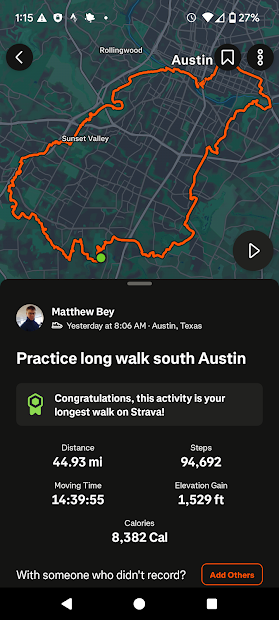
What I learned from this walk was that despite a lifetime spent in the science fiction writing community, and despite having once owned a utilikilt, and despite during the eighties sporting a mullet with a shaved head, walking with the walking sticks was easily the dorkiest thing I’ve ever done. But they were definitely worth it, just by slightly easing up on the stress my legs were getting. They also helped while walking through the dark. A number of times I would have ate it, as I walked through narrow wooded paths and tripped on roots and rocks (something that won’t be an issue on the Megamarsch, it’s all reasonably paved), but the sticks caught me before I fell.
A more important realization came when I took my socks off and realized that while crossing a creek a small amount of water had seeped into my shoe and caused horrendous blistering damage to the skin. My solution to that was another trip to REI to get waterproof trail runner shoes.
I only had one practice walk left and it was already too hot in Austin to go for a truly long distance. This was the biggest risk I took on this whole event, walking the 100km on shoes that I hadn’t fully tested with a 30- or 40-mile walk. But it was the last weekend for me to train, because you don’t want to go take a long walk in the two weeks leading up to the Megamarsch, just so your feet and legs have time to knit up.
The final practice walk I took, I walked between the Austin moontowers, a loop of about twenty miles, because it was something I had never done before. I had two friends go with me, the friend from the second walk and a new friend. Neither of whom could walk more than about ten miles without significant suffering.
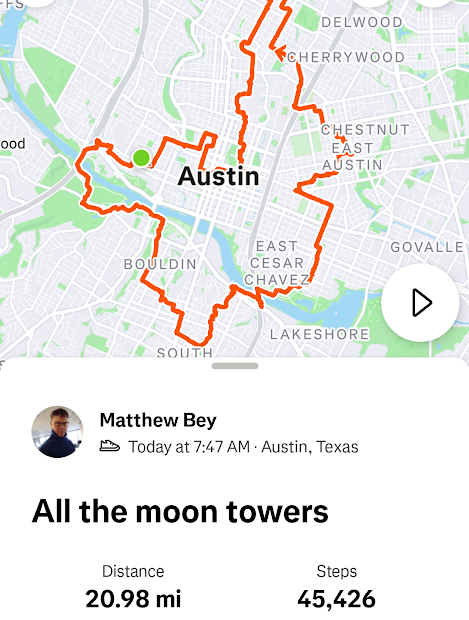
So by describing the walks I did in preparation, what I’m trying to say is, you think that you’ve done long walks before. But whatever you did in your pre-Megamarsch life, it probably isn’t enough.
Gear
I think I spent about $500 at REI gearing up for this, and I probably should have spent more. Considering how much time and money I was putting into this project, just by flying to Germany, I didn’t want to fail completing the Megamarsch due to cheaping out on something I would later discover I really needed.
At this point I should mention that some of the REI employees who helped me purchase equipment were really impressed by my casually-mentioned interest in walking 100km in 24-hours, and some really weren’t at all. None of them had heard of the Megamarsch.
Here’s a checklist of gear to get you started:
Medication and Ointments to Apply Before the Walk
- Gold bond medicated powder (see the blister section below)
- Moleskin on risky spots on feet
- Vaseline for chafing zones
- Chapstick to prevent lip peeling
- Sunblock where exposed (although in Germany people don’t seem to worry about the sun, which is cold and distant and obscured by clouds)
Packing Lists by Module
Wearables
- Long boxers (prevents riding up and extra chafing)
- Hat (for the sun which is in not necessarily in Germany, but definitely in Texas)
- Fleece
- Longsleeve undershirt
- Belt (best to note every item of clothing you can, even if it seems obvious)
- Hiking pants
- Technical shirt (if you’re keeping track, this is the third layer, if you don’t count the rain gear)
- Backpack (you don’t need a crazy big hiking backpack, but a large-ish and ergonomic one that can hold gear and a clothes. Be sure to practice hike with everything packed that you’ll have on the actual event, natch)
- Sunglasses (more for Texas than Germany, and only for the daylight hours at that)
- Hiking socks, three or four pair (these are more expensive, but also more padded than regular socks. Also, typically made from wool, because sheep never, ever, ever get blisters)
- Hiking liner socks, three or four pair (I got the thin sock liners with articulated toes. If there’s a chance they’ll do any good, try them out)
- Trail shoes (I’m of the opinion that a comfortable pair of waterproof trail running shoes is the perfect shoe for this event. They may prevent you from disaster if it rains, and they’re light and padded and flexible. I saw people wearing full-on hiking boots, but I feel they’re too likely to cause sneaky blisters beyond the 30-mile mark)
- Reflective stuff/tape (I was told that Germans do not walk around outside near roads without some sort of hi-vis safety gear. This is not just an insulting stereotype)
In Pack
- Extra hiking socks liners, three or four pair (you will want to change them at every rest stop, or you risk moisture buildup just from sweat)
- Rain gear (hopefully you won’t need it)
- jacket
- pants
- Snacks (don’t expect too much from the rest stations, and the track doesn’t go past anything that an American would recognize as a convenience store, not that Germany would allow that sort of thing to be open on a weekend or after 5pm)
- Cutlery (this was recommended by the Megamarsch organization, but I don’t think it really came up, except for a soup they offered at one rest stop)
- Reusable cup (you will need this for the powdered tea, coffee, or hot chocolate they offer at the rest stops, which will taste absolutely wonderful)
- Water bottle (there will be plenty of water and electrolyte powders available)
- Charged phone (by now you should have an idea of what it will take to keep a phone with its GPS running for 24-hours straight. You will need this for double-checking that you’re on the course, figuring out where the nearest train station is if you bomb out, and of course tracking your Strava course to show everyone on social media later)
- Charged ear buds
- Head lamp and extra batteries (you’ll be running the light all night)
- Downloaded many audio books (unnecessary if you have a buddy with you, which is probably the best gear there is)
- Red/rear bike light (a lot of the walkers put this on their packs to reduce their chances of getting run over, although I never felt like we were in sketchy traffic situations)
In Your Hands
- Walking sticks with rubber tips (although these can be collapsed and strapped to your bag at the beginning of the walk which makes you look cool and serious in a way that actually using them does not)
Medications
- Moleskin
- Vaseline
- Gold Bond Medicated Powder
- Sunscreen
- Chapstick
- Blister kit
To Pack on Practice Walks
- Dog bowl
- Dog treats
Blisters: Your Ultimate Enemy
They say the first rule for finishing the Megamarsch is: Don’t get blisters. The Germans swear by an ointment that means “deer musk salve”, which they’ll then admit no longer contains deer musk. It also cannot be attained outside of Germany. It looks like Vaseline to my unpracticed eye, but I’m told that it’s more than that. Since I couldn’t practice with it, I used a different strategy entirely.
Here are my anti-blister tips:
- Practice long walks (30-plus miles) to toughen up your feet and find faults in your footwear and gear.
- Wear the right shoes. For me this meant full padding on the sole and half a size larger than what I usually wear.
- Wear hiking socks and hiking sock liners.
- Keep your feet dry. Waterproof shoes and rain pants may be necessary for this depending on the weather.
- Apply a liberal dusting of Gold Bond Medicated Powder. This is supposed to keep the foot-moisture level in check. I applied this to the inside of my socks before leaving the states to avoid having to explain my jar of white powder at every international boundary.
- Change out your socks at every rest area (20km) to prevent buildup of moisture. I cheaped out on this because each set of hiking socks and liners costs about thirty-five bucks, but I should have done it.
- Address the sensation of a blister forming as soon as possible. You may need to apply blister tape such as moleskin or the donut-shaped adhesive pads that keep pressure off the blister.
Hamburg Info
Apparently Hamburg has a reputation for being ugly. This is sheer European chauvinism, because it’s a lovely town. There’s lots of green space and bridges and ponds and creeks. So what if there’s no medieval village experience or enlightenment age public monuments? It’s perfectly fine.
Public transportation is very convenient with trains going everywhere you want to go, and public transportation options near all the Megamarsch rest stops in case you want to finish early. Routes can be determined and fare can be paid through the HVV app which accepts credit cards and has a perfectly reasonable English language mode. Every train stop has a fantastic bakery with to-go pastries and sandwiches and the like.
One thing disconcerting about Hamburg is that apparently credit card use is rare. Mostly people use bank cards, so you’ll need to have cash on you for most situations.
Specific Walk Info for Hamburg Megamarsch
Presuming that these details hold true for upcoming years, here’s some information to keep in mind.
The walk starts from the west side of town, just south of the river, and then proceeds in a rough circle around the outskirts of the city. This is counter-clockwise for someone looking from space. There’s a lot of green space trails, parks, sidewalks, and a lot of alleys through allotment gardens. There’s an official app with the route, but they also post the route as a geo tagged file that I was able to import into mymaps.google.com and import from there into my Google Maps. The route has a number of chalk marks and laminated paper signs, and there’s usually a number of other participants in view, so it’s hard to get lost. Much of the walk is effectively a continuous stream of people with backpacks.
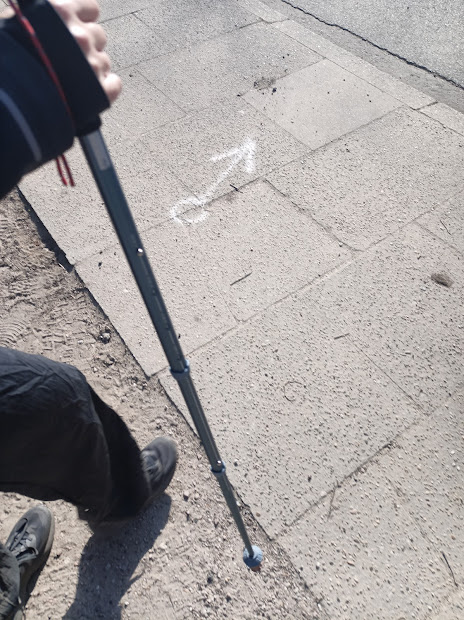
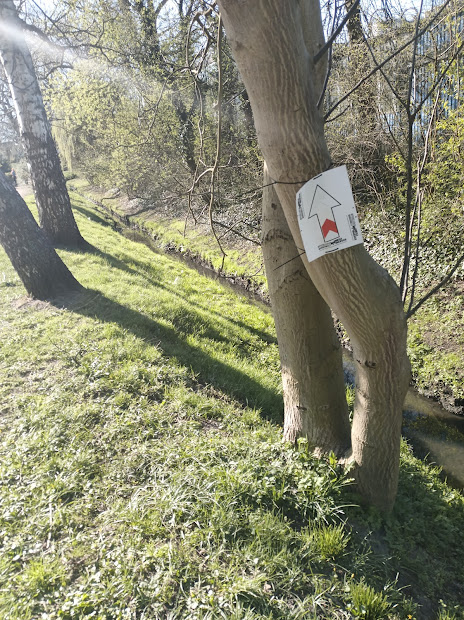
Rest stops are spaced roughly every twenty kilometers, 20km, 40km, 60km and 80km. They can be pretty crowded, but it’s easy to fill up on water and grab a handful of snacks. Some have indoor areas where you can warm up, but the fourth one didn’t, which is too bad because that was at the coldest point of the route. Apparently you can get partial completion certificates at these stops, should you care to do such a thing.
The finish line was at a park on the north side of the river, not very far from the starting point as the crow flies. Everyone was convinced that it was actually 103km. Several bus lines stopped within feet of the finish. There’s a finisher’s medal and a certificate (which is impossible to keep from wrinkling). A finisher’s shirt is available for an extra 40 Euros.
In 2025, the Megamarsch Instagram channel announced that 1700 people started the event, and only about 900 finished the 100km.
My Own Experience
To give you a more intimate account of the experience, the rest of this blog post is a journal account of my Megamarsch walk of April 18th, 2025. For the sake of suspense, you’ll have to read to the end to see if I successfully completed it!
We took a train to the port stop in the morning. My German friend had to run back to the apartment (literally) when she discovered that she had got the wrong shoes on when leaving that morning. I bought her some pastries from the Hauptbahnhof bakeries while I waited for her to take the train back home and then return. From the port, we took a ferry downriver to the Megamarsch starting line. There were a bunch of other people going to the same place on the ferry, but it wasn’t packed as my friend had worried. None of the other obvious participants said a word to us, which I feel is pretty standardly German.
The sign-in period went pretty quick. I got a hiking passport stamped, and I bought a participant t-shirt. I have no idea what I’ll do with the hiking passport, probably just put it in my files and forget about it. We almost missed our release time, since we were waiting in the wrong place, but my friend figured it out based on what the guy on the PA was saying. He razzed me when I ran up late, something like “he always does what she says”.

The walk started out wending its way through the agricultural sections south of town. Little farmhouses and little orchards with harbor cranes on the horizon. A few traditionally constructed reed roofs here and there. The path would go along the top of a dike (deich) for a while, and then go down into a hamlet’s downtown. We weren’t gone very far before it became clear that German’s don’t mind just peeing in front of a crowd. Which is good, because almost none of the promised public toilets along the route were open.


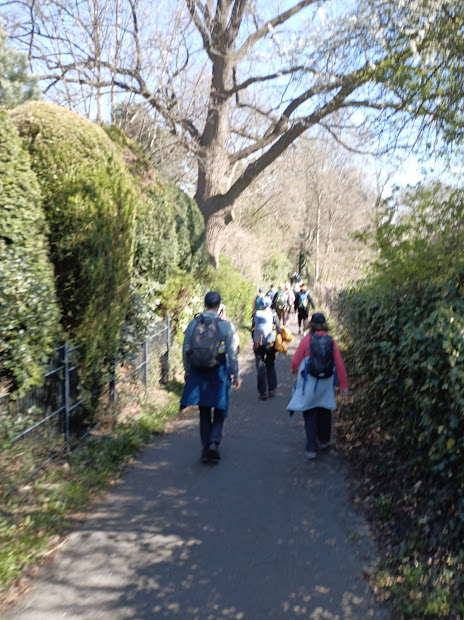


The first time we passed a Schreber Garden, I took a pic thinking I wouldn’t get another chance, but no, we passed hundreds of these gardens before the walk was over. They’re allotment gardens, each with a tiny house the size of a shed, and a lawn and vegetable garden the size of a handball court. Each one has a radically different aesthetic and design. Some had trampolines and some had topiary. We passed one that had a wild west theme, with wooden windmills and statues of cowboys.

The first rest stop (20km) was in a big gymnasium. It was crowded and a party atmosphere. A pro photographer snapped everyone’s picture as they came around the last bend to the stop. I flashed her a “gang” sign and she flinched a bit.
My friend, being female had to wait in line for a portapotty, but I was able to jump ahead when I realized that the device that I had assumed was a hand-washing station (she had assumed that too) was actually a carousel pissoir. Inside the gym different stations offered power bars, bananas, electrolytes and tea, and a tiny finger sandwich of two dry slices of rye bread with a slice of cheese between.
The usual pair of pretty young women handed out the usual cans of Red Bull, having arrived in the usual tiny car with a giant Red Bull can on top. Outside, a triangle of metal fences held a selection of garden hose spigots for refilling water bottles.
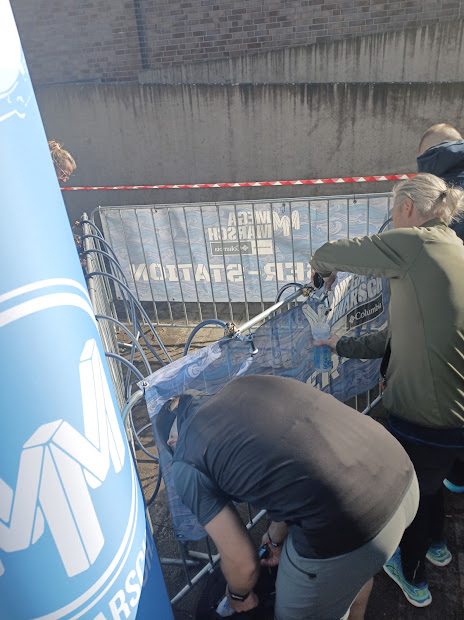
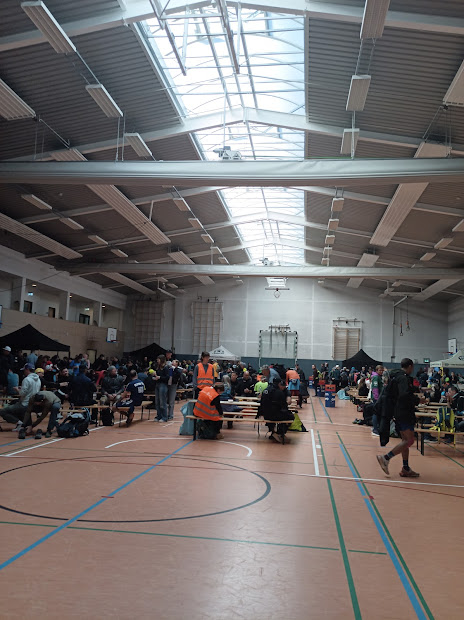

As the sun set, we approached the second rest stop (40-ish KM), which was in a working class neighborhood that my friend called the Elbe Island. It was in a climbing gym, the largest I’d ever seen. People sat around inside, taking off their shoes, and for the first time I saw people with terrible blisters starting. One old lady had blister tape around every single one of her toes. My friend spent a good period of time rubbing the “deer musk oil” into her feet. It looked exactly like Vaseline to me, but I was told there was more to it than that and that they no longer put deer musk in it.

For about a mile after the second rest stop there was confusion about the path, with some of the street markings differing from the online app route. We split from the main group, but everyone seemed to funnel back into the same route.

It was complete darkness by the time we made it to the bridge over the river. On the north bank we angled into the paths along the river greenway. There were no street lights, so I had to break out the headlamp, which I turned onto lowest power. A string of headlights stretched behind us, glimmering in the dark, and reflective backpack tape and sporadic red blinking bike lights stretched out in front. We couldn’t see much. At one point I walked over the levee to see if we were missing any spectacle, but it was only marsh. We passed an outdoor art park and a tree filled with heron nests which we smelled more than saw.
As we moved through a greenspace along a pond, I could see the the bobbing lights of the walkers ahead of us, lighting up the ghostly branches as they filed into the dark forest like Hansel and Gretel. Luckily no witches were spotted.
As the night progressed, the temperature dropped. This was the tradeoff for having an endurance event this early in the season. We didn’t have to worry about over-heating during the day, but it actually dropped below freezing overnight. In the morning I would snap a pic of frost and wildflowers. My friend was having a tough time keeping warm, accentuated by her prior reluctance to pack more layers because of weight concerns. And then she also had digestive problems from a recent trip overseas.
We passed the 50km marker, a printer paper taped to a road sign. It wasn’t the halfway mark according to our tracking apps, but we took a photo by it anyways.
My friend and I started to joke about the reason why we decided to do this. Her boss had given us a list of tips she’d put together. Most of which were extremely helpful. One idea to help keep up motivation in the crucial final kilometers was to write down the reasons you wanted to do the Megamarsch in the first place, and to read those reasons again to remind yourself when you’re flagging.
The only reason we could think of was, “Because it seemed like a good idea.” We pretended to open up this piece of paper and read out loud, “Because it seemed like a good idea,” and then questioned whether we’d written anything else down that was more encouraging.
The third rest stop was easily the weirdest. They had a tent with space heaters, but the place everyone wanted to go was the tiny institutional changing rooms with the jail-like lockable cages. My friend said they weren’t normal for Germany. The walkers stuffed themselves shoulder to shoulder into these rooms.

A guy was lying on the floor of one of these cages, directly under my friend’s feet. I had to step over him to get to the bench along the wall. My friend had her shoes off and was rubbing the stag-musk oil into her feet right above the guy’s face. He didn’t complain about it, just lay there, staring blankly. This was the only time during the 24 hours when I had to take a dump and it took forever to get an open toilet. When my friend was finally ready to go, I grabbed a giant liter bottle of Coke, figuring I could use the sugar and the caffeine. That stop also offered a hot lentil soup, but I figured I was farty enough already. Did I mention that I was farting non-stop? I’m guessing it was the peanuts in the energy bars I snacked on during the walk. Legumes, y’know?
The dawn broke with incredible slowness. It started with sporadic birdsong, even as the sky remained black. It was a different selection of birdsong than I’m familiar with in Texas, but after downloading the Merlin app European selection, it was clear that most of the birds were European Robins or Eurasian wrens. A slight variation on the normal selection of North America.
It was about this time, while taking a possibly unnecessary side trail at a pond, that I stepped wrong on an uneven cobblestone, and my left knee started to come undone. The stumble couldn’t have been more than a centimeter or two, but it caused a pain behind the rim of my kneecap that just started getting more and more painful. Keep in mind that while my legs were pretty shot at this point, but as long as I kept walking, they were pretty functional. Any time we stopped, the stiffness would creep in, and I would have to shuffle instead of step. It’s an odd sort of feeling, not really pain, but definitely not comfortable. The knee was a sharp pain on top of that.
Sunrise came as we walked through the cemetery. My friend had mentioned it before as a good place to go while visiting Hamburg. It looked like they had left open a back gate for us, and only the walkers were there. Going down the central boulevard, we had to use the very middle of the road, because the slight tilt at the edge of the road made walking surprisingly difficult.

And then I felt the tell-tale pang of an oncoming blister. Immediately I had us stop to investigate. I hadn’t taken off my shoes this entire time, even as my friend repeatedly re-applied her lotion. My plan had been to apply the Gold Bond Medicated Powder into the socks back in the USA, and then have that dosage last the entire walk. Sitting on a bench next to yet another Hamburg pond, I made the shocking discovery. Because the Hoka trail runner shoes I wore were waterproof, they had trapped moisture against my foot. Both my socks were noticeably damp, despite the cold my feet had been sweating the entire time. And the skin beneath the socks was a dangerous water-logged white. You know how a drowned worm in a rain puddle looks? That’s what the skin on the bottom of my foot looked like.
So I changed to my spare wool hiking socks. I had worried these winter socks were too thick for the shoe-size, so I forbear the sock liner I had practiced with. This strategy seemed to work, because I got through the walk without any noticeable blisters, except the pinky toe of my left foot which became a giant disturbing blood blister, like a toe inside a tiny inflated condom. But that toe is hardly worth mentioning.
They setup the final rest stop, 80km, on the field of a private soccer club. Disappointingly, they had no warming facilities. So my friend sat on benches covered in frost to apply her last cream routine. We considered getting the consolation certificate, but I figured we didn’t need to bother, because we were definitely going to finish. I thought to myself, 20km is easy. That’s only about 12 miles. Which is only like running two 10k. And I can run one 10k in under and hour. And walking a 10k is super-easy.

It’s hard to describe just how long those last 12 miles were. Every mile ticked down with extreme slowness. The other Megamarsch participants were pretty spread out at this point. But you could pick them out from the Sunday morning joggers, dog walkers, and park visitors pretty easily. They were the ones wearing backpacks and shambling, tilting back and forth like zombies as they put one foot in front of the other. We passed through the soccer stadium district, and we still saw a few Megamarsch folks peeing just off the path, which I was told was out of line in broad daylight in the middle of the city even for Germans.

We’d been talking nonstop for the past nearly-24-hours, about what in particular I probaby couldn’t tell you exactly. But at this point I started lagging a bit, concentrating on putting one foot in front of the other. My friend called me out on my silence, so I made the effort to engage more, and it really made the difference in terms of personal enjoyment and the sensation of the passage of time.
When we got to the edge of the park that had the actual finish line in it, somewhere on the other side of the park near the river, we had to pass underneath a subway track by going down stairs. Going down those stairs was awful. We basically went to opposite sides of the stairs, planting our butts on the handrails and standing sideways while we lifted our legs down each step one at a time.
We crossed the finish line almost exactly 24 hours after starting. A strange lady stood just before the end, spinning a party favor crank and cheering as we approached, while normal park visitors crossed the path all around, apparently not realizing something was going on. Three people met us at the other side of the finish line. One person put a finisher’s medal over our heads, another handed us a glossy certificate that said we finished, and the third person must have done something important which I don’t remember.
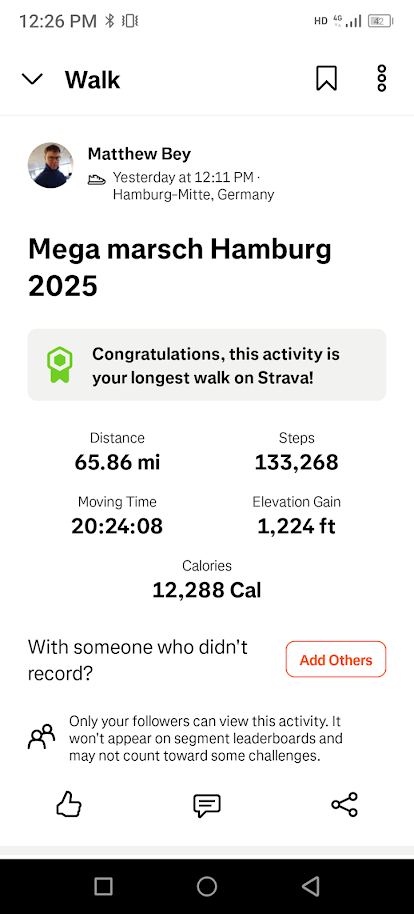
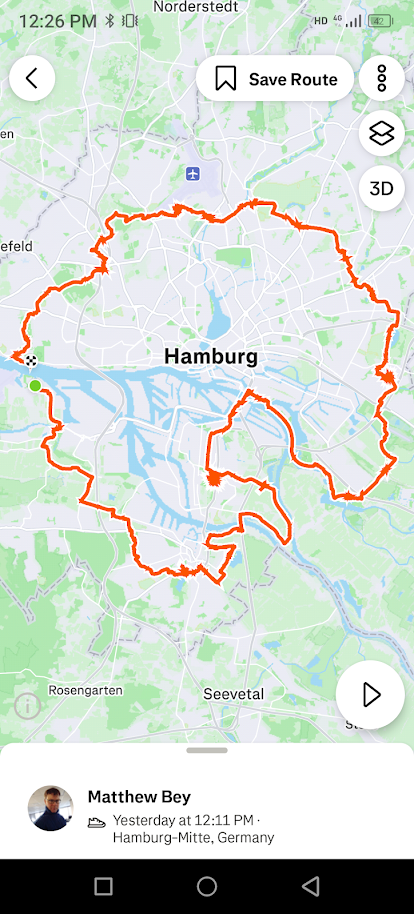
While we were sitting down on the hard benches by the finish, drinking non-alcoholic beer and eating more of the weird German energy bars, my friend says to me, “I feel dizzy. I need to stand up.”
A part of me was thinking, standing up is the worst thing to do if you’re feeling dizzy. But I didn’t say anything. But I was holding onto her already as she fainted. I helped her back down to the bench, and it was clearly dramatic enough that another woman helped me put up her feet and signaled the paramedics. The paramedics were nice, pretty much the same as paramedics everywhere. They couldn’t find her pulse, but declared her okay anyways. They put her name on the clipboard, where she was the seventh of the day. The incident seemed to be the result of my friend not eating enough and then stopping suddenly.
I got the finisher’s shirt (40-euro value), because that was something that I could wear all the time, unlike the medal. Even I’m not dorky enough to wear an event medal in public. We took the bus back to her apartment, because I didn’t want to walk down all the stairs in the subway. We had to use the walking sticks to shuffle our way off the crowded bus. After getting a fischbroetchen at the very long Hamburger Meile, apparently the world’s longest mall, I slept for 18 hours. I don’t think I’ve ever slept that long in one go in my life. I got up a few times to pee, but there was more sleep waiting for me.
When we were both finally awake again, we finished the recuperation at a German sauna. There was still a bit of a trick pain in my knee, but it was way better. An outside observer probably wouldn’t have noticed that I was walking weird. Buy the end of the sauna my knee felt a bit woozy (if you can imagine a human joint having that feeling), but otherwise my legs had returned to normal operation.
So, on to the summary and the moral of the story. Before I went to Germany, Jamey kept asking me why I wanted to walk 100km. He asked the question the same way that my relatives have asked me why I wanted to move to Texas, as if they couldn’t fathom why an otherwise sane person would attempt such a thing. There’s definitely a throughline between walking 100km and the time I canoed the Mississippi River or the year I spent touring the country on a motorcycle. Both things I decided to do with very little forethought or deliberation. I instinctively understood that with a bit of preparation and quite a lot of stubbornness and pain tolerance, I could accomplish it (this is also why I want to do the Texas River Safari one of these years). There was also the element of supporting a friend. My German friend comes to visit me in the US all the time, and I have only visited her once before. She had said that if I hadn’t been there that she might not have finished. Considering that she clearly stretched herself to the very edge of her physical endurance, this is a credible statement. And finally, I like traveling more when there’s a reason for it. Going to a foreign country and just walking around and seeing the sights and drinking in the bars is fine, but it lacks a sense of accomplishment and a hefty dosage of the memorable.
All that being said, when people ask me how it was, it’s hard to say “it was fun.” It was memorable, I have a medal and a finisher’s shirt that mean something, I got to see a lot of a strange city in a strange country from a strange vantage point, and I got a lot of quality time with probably my oldest friend.
Would I do it again? Nope.
I learned a lot from this, including that if I want to bring my cocaine on a trip to hamburg, I should sprinkle it inside my socks before packing them. I am very glad stuff like this exists and impressed with your walking and blister management skills!
Thank you! And I see that someone else also still employs an RSS reader!
Is there a German word for voluntarily inflicting pain and suffering on yourself just for fun? I bet there is.
Great post!
yes, it’s schadenfreude spelled backwards